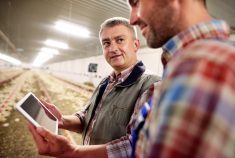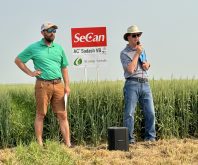If anyone in Canadian agriculture knows how to push the traditional financing envelope to stimulate growth, it’s got to be Greg Appleyard from Strathmore, Alta.
“There were points when I leveraged the buttons on my shirt,” Appleyard says.
In the nine years from 2003 to 2012, Appleyard went from farming 5,000 acres and 500 cows to being at the epicentre of a farming kingdom with numbers like 25,000 acres of crops, 2,500 cows and 40,000 head at Cattleland Feedyards.
Read Also

Riding the tariff rollercoaster
Farmers are accustomed to roller-coaster years. But the current geopolitical windstorm is something else entirely. On his cattle operation near…
In addition to all that commodity production, Appleyard’s companies offered trucking, cattle and grain marketing, bull testing, custom work, and fixed equipment for the gas and oil fields.
Before we get into that story, however, it’s important to emphasize that Appleyard does know farming. In the midst of all his growth, he was busy innovating.
For instance, research lots were created with GrowSafe pens for radio frequency identification so feed conversion and efficiency could be measured and managed. In 2009 these pens with data collection were offered to producers who wanted RFI data on their bulls.
The cropping operation, Creekstone Farms, also invested early in auto-steer and variable-rate fertilizer application, and Appleyard parlayed his feed conversion data and no-till seeding to tap into Alberta’s lucrative carbon credits.
Equally important is to emphasize that the strategy for these leaps in scale, diversification and technology has always been the same. It’s to find partners and competent individuals to manage them.
In fact, underneath and supporting the whole enterprise are a soup of individuals, numbered companies, partners, managers, ever-shifting assets, inventory and financing agreements. Stirring this pot and aggressively feeding the fire is Appleyard.
“I leverage everything,” Appleyard says. “It’s not an asset unless it’s getting leveraged.”
Traditionally, farm assets have depreciated faster than inflation, Appleyard explains, so if assets aren’t leveraged for growth, they’re just going to drop in value. Before the latest run-up, land prices increased at 5.2 per cent per year while the average interest rate was nine per cent. So, he is convinced, the only way to stay ahead is to borrow based on the current value of land to make more money from that asset.
Start-up
After building up his own cow-calf and grain farming operations while working for Ben Thorlakson’s feedlots and holding down another job, the then-27-year-old Appleyard wanted to buy the 20,000-head feedlot.
Appleyard and his wife, Candace, mustered up enough courage, capital and lending power to buy the bricks and mortar. However, they didn’t have enough financing to cover the massive inventory costs of a feeder operation this size. Then BSE showed up in Alberta and wreaked havoc with exports.
Instead of giving up on the purchase, Appleyard went looking for partners. After talking to some established cattlemen who wanted him to operate the feedlot their way, he went to his accountant to ask how to create venture capital agreements. After looking through the numbers, his accountant, Karen Gregory, and her retired vet husband, Joseph, decided to become Appleyard’s partners in the feedlot.
They made a good team. In Karen’s town office, she crunched numbers. At the feedlot, Appleyard made deals and focused on growth. He brought in new ideas, people and businesses. She created financial structure to help make good decisions, and this information enabled them to seek out financing and partners. “I was a gunslinger and a deal-maker,” says Appleyard. “She (Gregory) kept us from going broke.”
Moreover, they each brought with them a very different network of potential investors and customers. “Between the two us, we were able to pull in a lot of capital,” says Appleyard.
Appleyard credits Garnet Altwasser, who started Lakeside Feeders Ltd. (which was later sold to IBD and eventually Tyson), for kick-starting their operation. Even though Altwasser had his own finishing facilities and really didn’t need to put cattle through the yards, the young upstart from Strathmore asked for help.
Altwasser came through, contracting 14,000 head at cost-plus to heavy weight of 1,670 pounds. It was Cattleland’s first whole turn and it helped project them into a decade of growth and innovation. Appleyard continued to ask for help and aggressively pursue expansion — land, feedlot customers, cows and other businesses — even when profits were tight.
However, acquiring financing was a bumpy road with many turns. When the long-term implications of BSE hit the beef industry, the bank that originally backed the feedlot pulled their operating loan.
HSBC Canada stepped up with a $500,000 operating line, which at the time seemed outrageously huge to Appleyard. Not long after, this financial company switched account management internally and dropped Cattleland’s agricultural lender in favour of one with an oil and gas portfolio. Soon the trust between Appleyard and new HSBC account manager went up in flames, and subsequently so did the loan agreement.
Appleyard was back looking for financing, which he found in multiple places. BMO helped finance some smaller sub-companies, FCC stepped in for the land portion, and Chinook Credit Union took on the feedlot loan.
Like many of the co-operatively-owned credit unions, Chinook was a little more creative with how it structured its loans, but it’s smaller. Appleyard remembers walking into the local branch with a $4.5 million cheque for selling a feedlot full of cattle and no one in the branch had the authority to accept it.
It’s not only feedlot owners who have turned to credit unions for financing. According to Rob Martin at Credit Union Central of Canada, agricultural lending by the country’s 330 credit unions is on the rise. By the end of 2012, credit unions had issued $6.7 billion worth of cumulative agricultural debt, or about 10 per cent of total agricultural debt outstanding outside of Quebec. (Quebec’s credit union group, Desjardins, is not included in these statistics.)
According to Martin, Canada’s chartered banks accounted for 37 per cent and Farm Credit Canada 32 per cent of farm debt (outside of Quebec). The rest comes from private individuals, supply companies, trust and insurance companies and government agencies, such as ACC.
Over the years as Appleyard made his way through this obstacle course, he learned to always keep his financing options open and to deal with credit people who understood his business. He also learned how important information flow is to the lending process, especially for start-ups. He now meets monthly with a team of advisers, including his credit managers, to harvest their knowledge and experiences, and in the process he updates them on changes to his fast-paced businesses.
“I buy, I sell, I have all kinds of partners in all sorts of businesses now,” Appleyard says.
Appleyard’s accountant/feedlot partner at Cattleyard was excellent at keeping everyone on top of the financials. For example, Gregory created spreadsheets for profitability targets. Managers would then fill in their costs and connect their inputs to revenues per acre or per head. Everyone knew what their costs were, and Appleyard could hedge, buy and sell off those numbers.
Instead of speculating through this constantly changing maze of numbers, Appleyard hedged for certain margins.
“So many things impact profitability and move daily — fluctuating currency, inputs costs, interest rates, cattle prices…” says Appleyard, “… too many to track.”
It worked. He remembers one year making $1.2 million more profit by hedging than the cash market. Using this margin-based system to set prices for marketing and feeding cattle, Cattleland was able to retain and grow its customer base, even during the uncertainties of the BSE crisis and spiking grain prices. “I’m an options guy now, but I was a futures guy at Cattleyard,” Appleyard says.
From the Manitoba Co-operator website: Diversification may be bland, but it works
Using futures gave him a line in the sand. However, he keeps in mind that it’s easy to become speculative or over-contract physical grain and you really have to know what you’re doing. Says Appleyard: “Like a gun, hedging can be used to protect you, or it can accidentally kill you.”
Using these lessons Appleyard recently started Agra Risk Solutions Inc. With risk management software from his full supporting partner, FCStone, he now guides clients from Western Canada, the United States and Brazil through commodity risk management and he markets cattle and grain for them.
By inputting individuals’ information in the computer, he shows his clients how hedging can have an impact on profitability on their own farm, feedlot or ranch. He’s also able to physically buy cattle or grain and move them around the world.
“We’re bringing Wall Street to the kitchen table,” Appleyard says.
Strategic growth
With the feedlot established and growing, Appleyard began to expand the grain, oilseed and forage operation. When land became available, he jumped on it — during a time when it was available for much less.
In 2005, they acquired an astounding 62 quarters (almost 10,000 acres) near Clear Hills, in the Peace. However, they had trouble putting individuals in charge of that property and two years ago sold it for twice the purchase value.
After exceptionally good crop years in 2010 and 2011, Creekstone Farms was grazing and crop-farming about 20,000 acres of rented and owned land. “I’m an all-in kind of guy,” says Appleyard. “I was like a race horse when the jockey had dropped the reins.”
FCC, Canada’s biggest farm lender, financed the crop side. Of FCC’s $25.1 billion portfolio almost 40 per cent is used to finance crop farms. During the last fiscal year, its portfolio grew by almost $2 billion, about 30 per cent of the farm debt in Canada. At the same time, FCC had about one per cent more impaired loans for a total of $321.2 million, with value-added and crops experiencing the largest year-over-year increase.
Appleyard’s ideal lease-to-own ratio is three-to-two, for both the land and the cattle. At 60 to 70 per cent custom work and 30 to 40 per cent owned, they could stretch their leverage and meet their profitability goals. “A feedlot is simply a hotel for cattle that feeds three square meals a day,” he says.
They had reached the size that had tapped out their management capacity. The research lot was booked out three years. The feeder business was full. Operationally they were at maximum capacity.
After a health scare in March of 2013, Appleyard sold his part of the feedlot and now rents the grain land back to Cattleland. Part of the deal is a non-compete clause on buying more land (he owns about 7,000 acres now) or expanding the grain farming operation for two years.
Since then, Appleyard has started the commodity risk consulting business. Additionally, with a small team of partners from Brazil, New York and Chicago, he founded an agricultural investment bank headquartered in Manhattan. “Nothing beats going into a New York City office in jeans,” says Appleyard.
Among its current projects, One World Financial Partners buys land on behalf of investors with a focus on setting up replicable farms of the most efficient scale. The Western Canadian cropping units will be 6,000 to 7,000 acres, the ideal amount for maximizing two combines, one sprayer and nine grain bins.
Strategically, Appleyard sees this business model as becoming a leading part of farming in the future, with farmers owning and owing on proportionally less of their assets while maximizing the opportunity costs in scale, with outside investors owning farm assets and companies like One World brokering the deals.
Talk about creative financing.
— Maggie Van Camp is an associate editor for Country Guide at Blackstock, Ont.















